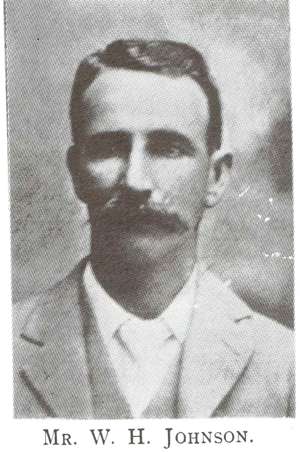 JOHNSON, WILLIAM HENRY “TAVUA”
JOHNSON, WILLIAM HENRY “TAVUA”
(April 10, 1862 — 1962)
Pioneer Island Trader
Property Developer
Ship Owner
Planter
Authority on Poker
Member, Suva Town Board.
By David Johnson.
![]()
The description of WH Johnson following is largely taken from the memoirs of Tui Johnson (“70 years and 1 month”) written in about 1975. For those who have read this, I apologise for the large chunks that have fallen without edit straight into this description. However that the reader will be largely reading the words as written by Tui himself should be of some consolation. The era of digital technology has allowed sourcing of additional material that would otherwise remain unread and unknown in the generational mists of time. Hopefully this can expand on some of the threads connecting Tavua to other members of the Fiji community that other readers will be familiar with.
Early Days
Unusually for the European settlers in Fiji who generally hailed from Australia, New Zealand or the UK, William Henry was born in 1862 in a little town called Port Dover on the edge of the Great Lakes in Ontario, Canada. As a child he was educated at Port Dover High School. Soon after completing school he left for London Ontario to learn a trade. He tried his hand at harness making, sewing machine making and cigar making. In the same period he served in the 7th Fusiliers (later the Royal Canadian Regiment) in London, Ontario. Presumably none of these fully piqued his interest because he then went into press work for a printing office, a vocation or skill that was to allow him to also work elsewhere.
From there William Henry seems to have gone on a peripatetic journey covering a decade in which he worked in various positions such as with Rand McNally in Chicago in 1880 and as a pressman in AL Bancrofts publishing house in San Francisco and for a time also in the regular army of the United States.
There is a story that he enlisted in the US army under the name Arlington on the basis that his name would be called early on pay day allowing him to get to the poker table early which would provide some advantage. The game would commence immediately on stand down on Saturday and continue without interruption until Sunday evening leaving just enough time for a little sleep and wash before reveille Monday morning.
William Henry had an aunt (from Paisley Scotland) living in Rockhampton Australia at that time and together with his mother they set off to pay her a visit. However his mother suffered a serious accident at a railway siding in Omaha and they had to return to Port Dover.
It was a year or two after this that William Henry set out again on his own for Australia but the cost of the journey was such that he was obliged to do some work as a coal miner in Utah to accrue the means to pay for a sea passage from San Francisco to Sydney in the original steamship “Mariposa” of the Spreckles Line, later the Matson Company. William Henry first came to Australia in 1891 travelling as far north as Cooktown. He returned to Sydney where he then spent a few months rolling cigars in a demonstration show room in Oxford St.
Levuka & Tailevu 1890-1895
Tavua then came to Fiji in September 1890 (then aged 28) in the steamer “Birksgate” under company instructions to work at CJ Sketchleys cigar factory in Levuka. He arrived in Levuka 1 day apart from Mr Frederick Carr an Englishman and an accountant who came via New Zealand. In subsequent years they would stay in the home of the Carr family in Levuka as good friends. At this time tobacco was grown on the southern and western sides of Ovalau, but the presence of humid climatic conditions, borers and weevils were too much and the venture closed down. While the business was floundering WH’s fiancée Blanche Elizabeth Wadeson arrived in Levuka and they were married in the Church of England near Vagadace on 21st November 1892. They took up residence in a house about 150 yards higher up the creek opposite the grounds of Levuka Public School. When not working WH would go pigeon shooting or he and Blanche would play cards. Amongst the couples they would play cards with were the only Chinese family in Levuka. These were the forebears of the Houng Lee family.
When the tobacco venture closed WH found himself in partnership with the Reverend Floyd of the Church of England, the same clergyman who officiated at his wedding. In those days Levuka had no milk supply as there were no areas suitable for the grazing of cattle. So WH and the reverend established a partnership for milk supply from a dairy farm at Mata Vata Cou on the Tailevu coast. (now the site of QVS). The milk run was conducted in a small half decked sailing boat. However the run could not be regular because the prevailing wind is not helpful and sometimes difficult or treacherous as the wind coming over the mountains and through the valleys of Ovalau forms sharp gusts and sometimes black squalls. When the conditions were unsuitable the only course of action was to try and convert the milk to butter which had to be done at night because daytime temperatures were too high and there was no ice or refrigeration. Deciding that dairying was too precarious and demanding WH and Blanche in a financially worse state returned to Levuka after turning over the venture to a brother of the reverend Floyd.
Tavua 1895-1906
WH had kept an eye open for opportunities that might be available elsewhere in Fiji and his attention turned to Northern Viti Levu. Along the northern and northwestern coasts of Viti Levu there were some Europeans establishing cattle and goat runs and some crops of maize, rice and pulses which were in increasing demand by the growing Indian population. Some Indians were already occupying small tenancies as and when their terms of indenture expired as not many chose to return to India.
The situation at that time was also that indigenous Fijian taxes were collected mostly in kind by way of yams, rice, tobacco, maize and yaqona. District Comissioners as well as being Administrators and preservers of law and order were also tax collectors. In the country districts there was little chance for reciprocal trade and so taxes accepted in the form of produce had to be turned into money or goods and had to be sent to where there was a market. Rice was in demand for issue to gaols, hospitals and staff in government, and labourers in the sugar industry and to a lesser extent on the plantations in Vanua Levu and Taveuni. The Fijian tax maize ended up consumed by horses and mules in the populated areas of Suva, Lautoka and Ba whilst the tax tobacco ended up in the hands of traders in Levuka and Suva who sent it to employers of plantation labour who had tobacco in their ration issue and also to storekeepers in the non tobacco producing areas of Fiji. Likewise Yams of certain varieties when coated with lime could be stored together with yaqona which could be distributed in the general food supply in districts where for reasons of climate or soil conditions they did not flourish.
In this way there was a method to turn tax produce into money value and the influence between supply and demand required traders to make a market between producers and suppliers. Henry’s weather eye saw potential along the north west coast of Viti Levu for a trader to handle a sufficient part of government tax produce and convert it to money at a trading post and in turn supply other goods to Indian settlers and resident Fijians.
WH had identified a gap along the coast at Tavua. At the time there were no other European traders in this area. Snow had a store at Naiserelagi, at Nananu were the St John and Munro families, the Thomas family at Yaqara and Burness at Caboni and of Chinese and Indian traders there were none. Having identified a site at Nakase at Tavua, WH had issue with not having any capital. The only bank in Levuka didn’t lend without security and he also had to get a piece of land with some security of tenure. The Australian firm Miller Heddy declined to offer support so he turned to Hoerder & Co as the German traders at that time were expanding. Hoerder & Co assisted in obtaining a site at Tavua and William Henry was soon able to commence business activities.
At this time Adolph Brewster Joske was her majesty’s District Commissioner and Magistrate at the hill station of Nadirivatu with a detachment of the Fijian Armed Native Constabulary. Adolph’s father was Paul Joske who pioneered sugar cultivation at the site of the old government buildings in Suva. Paul’s brother Alexander Brewster Joske formed the successful business with Leslie Edward Brown – Brown and Joske. On Adolphe Joske’s staff was Ratu Penjimeni Veli (later Roko tui Macuata) – a lieutenant in the Fijian Armed Native Constabulary and Ratu Aisea Vasutoga a nobleman of Nadroga also of the Fiji Armed Native Constabulary. In about 1920 when Ratu Sir Lala Sukuna joined the Fiji Civil Service he was supported by Ratu Peni and Ratu Aisea. The association with Adolph Joske was said to have left these three with impeccable manners as well as influencing their attitudes to all people. It was said that when visiting WH and Blanche in Tavua, Ratu Veli would not trump Blanche’s ace. This was accepted but where the trumps lay was evident.
There also exists a story that many years later on a visit to London in 1924 for the Wembley Exhibition; Maynard Hedstrom thought it would be unusual but interesting for Ratu Rabici and Ratu Veli to see the Folies Bergere. After the show Ratu Veli displayed an ongoing sense of amusement. When enquiring for the reason he told sir Maynard that he could not help being amused by the march he had stolen on Ratu Rabici – for Rabici on account of only having one eye had seen only half of what Ratu Veli saw.
The first trading site was far from the best. Today it is located near the Tavua township where the Kings road crosses the Matanigata Ck about 100 yards downstream of the current bridge. It was a wooden framed galvanised structure both store and dwelling. Goods, trading stock and supplies were delivered by the Adi Rarogo from Levuka and then moved by punts and dinghies up the creek.
Mosquitoes, sand flies, rains and floods and biting centipedes were aplenty. In heavy rains with flooding, the stock used to have to be hoisted to the rafters. Word that a “sitoa” had opened at Nakasi spread and in about 4 years they had made enough headway to shift to a better more elevated site near Korovou village at the point where the road from Nadarivatu joins the coastal road.
William Henry managed to get a small sailing boat the “Terravini” about 3-4 tons. With this he used to run up to the Yasawa’s to exchange trade goods for trochus and turtle shell, then much in demand for button manufacture. In time he acquired a lease of 15,000 acres extending from Nakase across to Matanagata Ck and inland for some distance. Portions of the leasehold were subdivided and offered to Indian farmers on a tenancy basis where the farmer agreed to sell his produce to WH as storekeeper and who in turn entered into an obligation to sell it. After some time there were over 400 souls in this farming community. The border of the initial lease was the creek that unknown to WH yielded small quantities of gold when panned by an expert such as Bill Borthwick and would then yield up further secrets. By then WH also had a lease of 4000 acres of freehold in the back of Tavua. It is possible that this is the Nasomo section where in the late 1980’s drilling by the Nasomo JV (between Emperor and Western Mining corporation) which intersected the Prince William Flatmake and which has now produced near a million ounces of gold.
WH later bought another boat the “Annie Sailor” of 12 tons which was used for the Tavua Levuka run bringing in goods for the store and taking out the farmers produce. Sometimes Blanche would make the trip to Levuka where she would stay with the Kramps or the Carrs. Once she travelled on the Rarogo to Suva where on 28th July 1900 she gave birth to a son William Granger Johnson. Dr Lynch the CMO delivered the baby. When brought to Tavua he was the first European child in the district and ceremony was performed at Korovou village led by Ratu Veli and Ratu Aisea and the child was given the name Tui Tavua (and thereafter known as Tui).
Once when WH was away, Blanche looked after a passing European stranger in need of shelter for the night. About 10 years later the passing stranger proved to have been Robert Crompton, an English solicitor who had established a practice at Ba. He and WH subsequently became close friends as did Blanche and Rose who both who worked with the Fiji Red Cross in Suva in WW1. According to Tui’s memoirs Crompton became the foremost barrister and solicitor in the Fiji of his time and also became a prominent member of the Governor’s Executive Council and the Legislative council. WH and “Bob” Crompton went on to become involved in a couple of speculative business deals
As the demands of the store at Tavua grew, WH commissioned Tom Nicolson in Suva to build another cutter. This vessel was quite large for those times of about 20 tons capacity. The vessel “Beaver” was built at Walu Bay by master shipwright TP Nicholson, father of Eileen (Lawlor), WT (Bill) later Suva’s Chief Electrical Engineer and Norma and Keva. Bill’s son Ken was a WW2 pilot and reached senior position in Qantas. At that time Emberson built ships alongside Nicolson. This was Felix Emberson’s father who married Matilda Anderson and produced an academically talented family of daughters and sons.
In 1906 the CSR company wished to extend planted areas to beyond Ba where there was an expanding mill. WH was ready to sell his leaseholds to the CSR Company and also disposed of his trading station to Picker Bros. In June 1906 the sale was completed.
Suva 1906 -1914
After selling up Tavua and a sojourn in Canada, WH and family returned to Suva where they rented a house in Knollys St. There were a number of individuals and families named Johnson in Suva about this time. There was JT Johnson, accountant with the Vancouver Sugar company who was referred to as either JT or Navua Johnson. There was a Leslie Johnson in the Registrar of Titles office who was referred to as just Leslie Johnson. There was Mrs Johnson who was the proprietress of “Athelstone”. Her son Trevor, as well as being an accomplished pianist, held senior positions in the Colonial Secretariat. In order to identify him William Henry became known as “Tavua” Johnson. At this time in the Knolly’s St Triangle were the Browne family, the Davidsons and the Bish family. In DesVoeux Road lived Mark and Archie Dods and nearby the family of Arthur and Jennie Griffiths.
Between 1906-1914 Tavua kept himself busy by building a row of five houses in Knollys St, 3 houses in Eden St and an apartment house in Disraeli Rd. He also secured a lease from government of a beach area in Suva on the western side of Victoria Parade and just south of a reclamation where the Westpac Bank Head Office and Branch is today. This foreshore was reclaimed under a contract with Carl Koester who used horse drawn drays and brought the soapstone filler from the site on which the Waimanu building and the Waverley accommodation house stood. The Waverley was on a prominent elevation and was in its time the residence of Gabriel Marks and then William Henry Marks. In 1911 Central building was completed for Tavua by Mssrs McNair and Marlow, contractors and builders. The CMLA building now stands on this site.
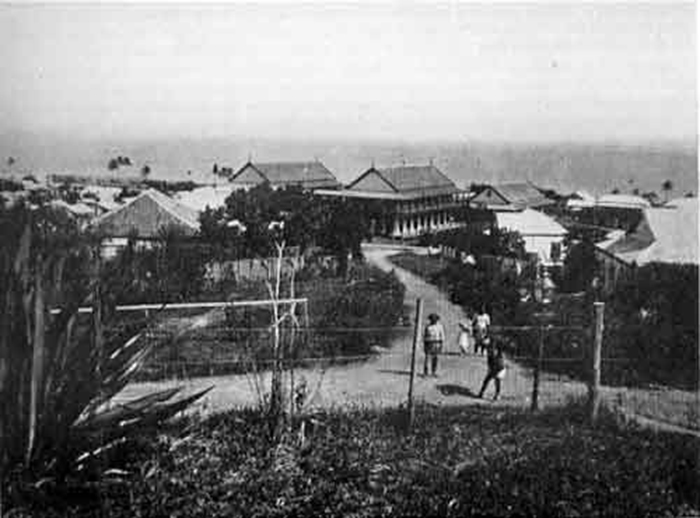
Tavua’s army experience served him well at this time as in between work and family there remained time for some fairly stiff stakes in Poker, generally played in the forenoon at the old Pier Hotel and sometimes the Melbourne Hotel. Charged with suitable refreshments the players were usually some of the well known Suva businessmen – Alec and Arthur Joske, LE Brown, Simeon and Lewis Lazarus, Fred Thomas and sometimes Gabriel Marks and JB turner. In later years WH was acknowledged an authority by the local clubs and reference was made for his ruling on points of uncertainty or dispute.
Savusavu West 1914-1918
Whilst Central building was under construction Tavua met Captain Hans Christian Hansen, a German who had arrived in Fiji about 1880 and had established an orderly coconut plantation on the western side of Savusavu bay. They were each having a birthday – 10th April 1911. Captain Hansen said that he was getting on in years and would like to go home to Germany. The Captain and Tavua agreed to negotiate and a bargain was struck. The buyer was to pay the Captain or his wife an annuity while either survived. Before the deal was consummated a severe hurricane struck but the arrangement was still concluded on the original terms. In this venture Tavua was joined by Robert Crompton and they became partners in the purchase of Vunimacawa Plantation and an adjoining property.
The purchase from Captain Hansen was profitable. Two annual payments were made before WWI commenced, then trading with the enemy was forbidden. When the end of the war came, the buyers did not know whether or not Captain Hansen or his wife had survived and how they stood in the deal. In the end it transpired that Mrs Hansen had died in 1916 so four annual payments had to be paid to the custodian on Enemy Property in Fiji. This ultimately was supposed to find its way into war reparations.
As a young man Tui visited Savusavu and the property a number of times. The landfall from Levuka was usually Nakama at Savusavu east, from whence one had to cross the bay. Mark Dodds in his auxiliary 20 footer “Mabel” or Oscar Barrack in his outboard dinghy provided the usual means for getting across the bay to John Dodds estate at Na Sekawa. Tui records that he would take his bicycle with him and ride 7-8 miles along a generally level foot track from Na Sekawa to Vunimacawa. At this time (1912-14) none of the children and only a few adults had ever seen a bicycle and resulted in swarms of children following Tui until exhausted they collapsed behind him.
At that time the Plantation was managed by EJ Hawksley. His sons, known as the Hawksley boys were well known in yachting circles and their mother was a member of the well regarded and widely known Towson family who had then been long in Savusavu west. It would appear that EJ Hawksley was the son of Edward John Hawksley the elder, in his time an English Catholic Radical who wrote much of the content of a then radical Sydney paper “The Peoples Advocate”. He is supposed to have moved to Fiji in 1863 where as an acquaintance of James St Julian he may have been involved in the early period of the Fiji Times.
During WW1 the price of copra had been high and Tavua and Blanche took up residence on the plantation to allow the manager to enlist for war service. Morris Hedstrom were the principal buyers and exporters of copra and sent their auxiliary cutters to load – taking the copra off the scales at plantation weights. In 1919 after the end of the war the partners sold the plantation to Jan Hing Loong and in 1920 Tavua and Blanche returned to Suva
Suva 1920-28 Borron House Suva
After leaving the plantation at Savusavu in 1920 Tavua and Blanche were invited by Mr James Borron Esq to take up residence at his home at Rai Rai Waqa at Waimanu road in Suva. At this time the house stood on 82 acres of land as many readers will know, the residence is a large Colonial style house and commands magnificent 360 degree views of Suva.
Here Tavua was able to install a full size billiards table and which than became a hub for social activities in Suva. Tavua and Blanches circle at that time included Bob Crompton who lived at Tamavua, then a full 2 miles from Suva. Amongst his other other attainments were and lawn bowls and as mentioned, cards.
In this period Tavua was a member of the Suva town board. As Chairman of the works committee he succeeded in getting a considerable length of concrete footpath and kerbing completed. In a southward direction this terminated at the foot of MacArthur St opposite the old Melbourne hotel. An American author and friend of Tavua’s, one John Russell, wrote a potboiler entitled “Where the pavement ends”. According to family lore Tavua claimed his other achievement was the introduction or improvement in the “night cart” system.
In 1920 Tavua asked Maynard Hedstrom if he would be able to start Tui on a business career. The story that follows from here can be told another time. Ultimately the house was too much for Blanche to look after while the extent of the acreage was also a problem and Tavua and Blanche decided to shift in 1928.
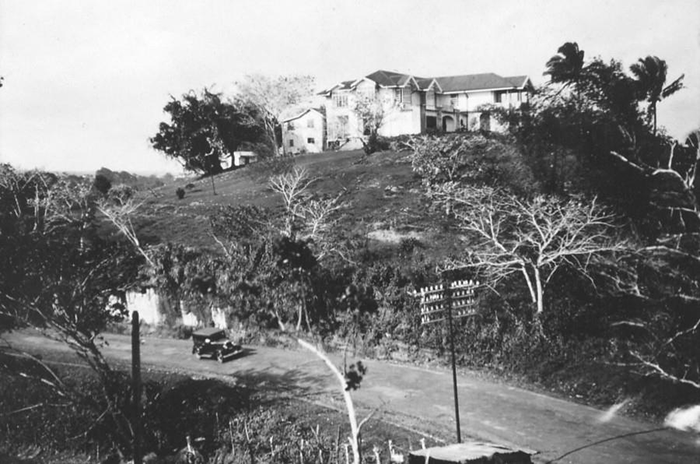
From 1928 – Garrick Hotel Suva
Tavua and Blanche took up residence in Dan Costello’s Garrick Hotel in 1928 where they had a suite. Now aged 66 he had achieved success by his own efforts and had experienced a rich seam of history in the process.
As a final gesture, when as an old man conscious of his remaining days he told Tui that he was prepared to be buried in Suva cemetery when the time came but only on the condition that he was buried in a place where “no priests foot has ever trod”. And so it came in 1962, his 99th year that he passed away and was indeed buried in Suva Cemetery. And his family succeeded in the task of burying him in an obscure part of the cemetery as neither Miles was able to find it or I have yet to.
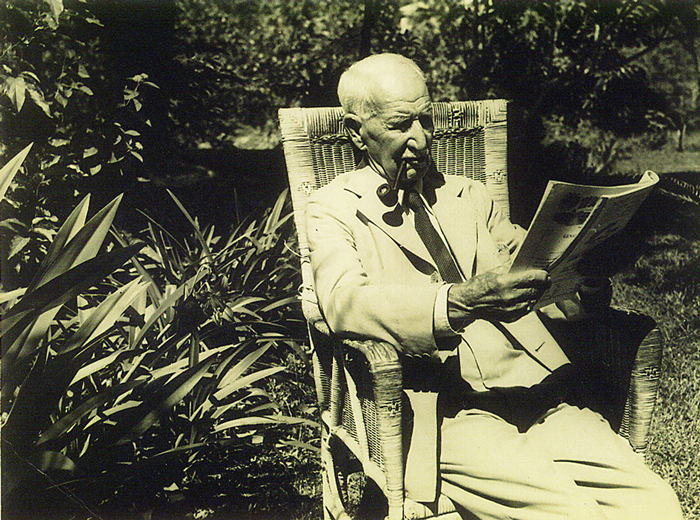
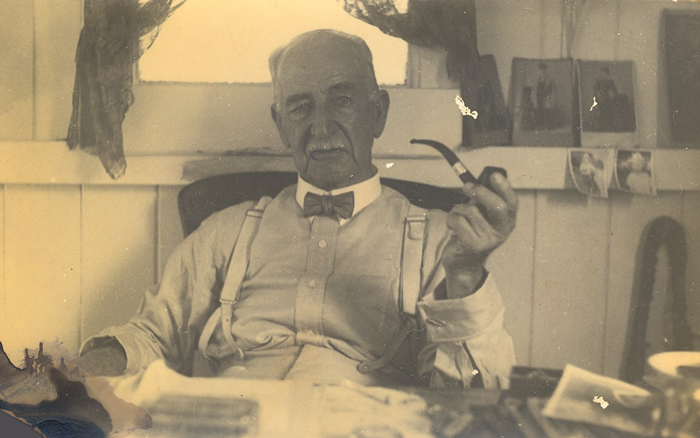
![]()
Entry By: David Johnson, Kensington, Sydney, New South Wales, Australia.
